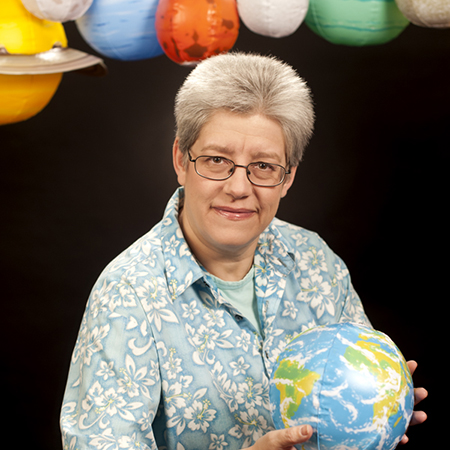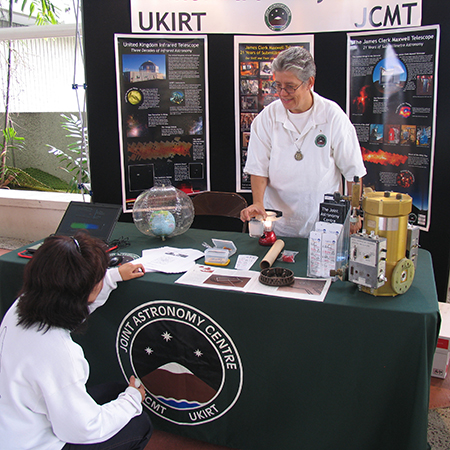“It’s a matter of time before we find other life forms.”
Inge Heyer, Ph.D., offers insight into space exploration
Inge Heyer, Ph.D., senior lecturer of physics, researches astronomy education and has published many books, including Investigating Astronomy, which is used in courses at Loyola. Heyer is helping organize the Fourth Annual International Astronomy Teaching Summit (iATS), which Loyola will host in July 2019.
The Berlin, Germany, native earned her bachelor’s degree in Astronomy and Physics from Smith College in Massachusetts. She went on to receive her master’s degree in Astronomy from the University of Hawaii in Honolulu, and her Ph.D. in Science Education from the University of Wyoming in Laramie.

With decades of space research and exploration, many questions remain. Loyola magazine sat down with Heyer to discuss a few space-related questions.
Why are researchers so interested in Mars?
We are so fascinated with Mars because it’s relatively close to Earth. The surface of Mars has similar features to Earth, including shield volcanoes and dried-up river beds, which can be seen on imagery from both Earth-based telescopes as well as Mars orbiters. We know now that water existed on Mars at one time, but where did it all go? Mars has a tilted axis like Earth, so the planet has seasons. Therefore, we can examine the features on Mars and learn more about our planet.
What got you interested in astronomy?
I went into astronomy because of Star Trek. It was first broadcast in Germany in 1971, when I was 10 years old, and it immediately struck me that the characters were very intelligent and worked together to solve problems. This resonated with me because in Germany at the time, everyone looked the same. The characters of Star Trek are highly motivated, and it gave me something to aim for. I thought if I work hard and dedicate myself I can one day join a group of explorers.
Why do you think teaching astronomy is important?
We need our citizens to be more comfortable with scientific arguments. We don’t have enough people who study engineering and other sciences. I see a fear of math in students at times, and we need to work to overcome that fear.
It is important to have a science-literate public. It is easy to be misled by the daily influx of information, and people need to be able to read graphs and scientific data to make their own informed decisions about science.
We also need the public to be able to see and understand the changes occurring on our planet. Climate change is happening and increasing, so we all should worry about the impact humans have on our Earth.
As the co-convention chair of the Shore Leave science fiction convention, tell us about that event.
Shore Leave is a fan-run science fiction convention where audience members can choose to attend various tracks of programming. These tracks include art, science, literature, costuming, science fiction, and many other activities. We have a stage masquerade competition, workshops, panel discussions, and our speakers are professional actors, authors, scientists, and artists.
At this and other such conventions, I often give talks about the search for planets around other stars, including the potential of life on these planets. Almost 4,000 such planets have been found to date. As to the question of life there…we don’t know that yet. Given the apparent multitude of planets, plus recent planet findings in habitable zones, there are probably other forms of life elsewhere. We can make some assumptions from what we know about life here on Earth. Life is made possible by a hot core, volcanoes, liquid water, and the building-block elements such as carbon and nitrogen. Given these factors, bacteria evolved, then developed photosynthesis and created oxygen, which is what most life needs. There’s not a doubt in my mind that there is life elsewhere, but in what form, I’m not sure. As far as I’m concerned, it’s only a matter of time before we find out.
Can Loyola students get involved with Shore Leave? If so, how?
Loyola students who participated in our Hauber Summer Research Fellowship Program in the past have presented their research findings to peers and high school students at the convention. This helps Loyola students show their work publicly, but it also gets high school students excited about college, which hopefully leads to more teens contemplating a STEM career.

What do you think the future of space exploration looks like?
This is something not easily predicted, but I would like to see an expansion of the exploration of the other planets and moons in our solar system. Not only are there fascinating worlds among them, but we can learn more about our planet from studying the others.
In addition to space exploration, we need to keep developing new technologies for both manned and unmanned space flight. I am still dreaming of a telescope on the far side of the Moon.
The way we receive information from space is through light. Light tells the story of everything that goes on in the universe. That’s why we have to learn how to collect it and how to interpret what the light is telling us. This is why we learn about spectra and wavelengths in class.
Your telescope is a time machine. If we want to learn about the history of the universe and how the first stars and galaxies formed, we need to look as deep into the universe as possible to catch some of the first light formed.